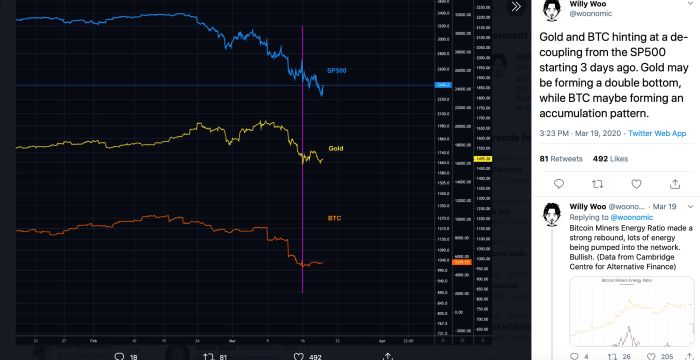Be it in crypto or legacy markets, technical analysis is something that people typically either hate or rely on blindly and religiously.
In a 2019 blog post on whether technical analysis in crypto actually works, we’ve talked about how knowing your patterns can give you better odds in trading.
We also acknowledged the limitations: “If there is an unexpected important event happening, it will always shake up the markets, no matter how mature and stable they are: China bans Bitcoin? Of course. How about China banning the US Dollar, though? Of course there would be a shake-up too!”
Even if the 2008 crisis is long forgotten now, in the light of the COVID-19 outbreak the limitation of “history rhymes” tactic of using technical analysis is probably more than clear.
That is only the most basic idea of how to use TA, though. It is also not a reason to ditch TA completely.
The best way to explain why will be to list the most common misuses and misconceptions about technical analysis.
Technical analysis should not generate illusion of complexity
Leave that for the Twitter gurus who keep their followers busy and engaged with the help of fuckarounditis.
The best yardstick is to see if your technical analysis is helping you make a decision.
If it isn’t doing that, you’re doing it wrong. No matter if you are using the “right” indicators and ALL the lines. (Ignore the reverse statement though. If your TA helps you make a decision, you can still be botching it.)
A sound trading decision should always be right there at the end of your analysis. If you’re leaving your chart confused, stop doing whatever you’re doing.
Technical analysis is not the source of truth
Keeping the same idea as with the last point, let’s reiterate that technical analysis is not the source of truth. This is a subtle thing that will royally screw you in the long run.
It is also one of the most common misconceptions you see among traders on social networks on forums.
Chart patterns and technical indicator values are not showing the truth about the market.
-
If you are a short time-frame trader, they point at regularities that may be happening on the market and the details of which are probably unknown to you. They are also not all that important as long as you are picky enough about which assets you trade.
-
For the long-term decisions, you get a bird’s-eye view of the market. You can see some vague tendencies and trends, and you definitely can see if it the activity is healthy hustle and bustle or ill-looking convolutions and tremor.
If you look at a chart and see “inverse head and shoulders, therefore I should open a 20x long”, go look at something else.
Technical analysis is not a formula to apply without any other considerations. Even trading bots need to be trained and backtested for specific market conditions.
Technical analysis is not faultless
This has been said before, and it is important enough to be repeated: Technical analysis works on the basis of probability.
Sometimes, market in a vulnerable condition will be exploited to oblivion, sometimes it will be left unnotices because there are better opportunities elsewhere. There may be a lot of money on the sidelines waiting for that subtle sign of strength but there may not. There also may be money on the sidelines looking for a market to invest in and eventually not finding anything better than crypto, and thereby generating a sign of strength.
- You see a bullish divergence? There is an emerging strength in the market, but it is still very easy to kill this strength.
- You see a resistance broken through on good volume, already after a throwback? That’s a sign of strength that is significantly harder to kill.
But remember, that everything on the market is a negotiation. There is always variance. You will be wrong sometimes.
So, what gives?
Technical analysis is just a tool
With all that said, it boils down to the same thing: Technical analysis is just a tool.
Ideally, you will get comfortable with using technical analysis to such an extent that it will help you make a value judgement.
To use technical analysis as a framework for value judgement, you will find it matters less which exact indicators you use. Obviously some tools are more suitable to use on longer trades and others for scalping. But in general, the idea is to stick to a toolbox with which you are comfortable.
You should roughly understand what your tools are doing. That does not mean you have to know the mathematical formula, practical understanding is enough.
You have practical understanding of an indicators if you know what kind of information it brings out in the chart.
If you want an example, read the Glossary entry for the Bart formation.
Best TA tools to facilitate strategic thinking
Comparison with other markets
One of the best ways to “zoom out” properly is to look at other markets than the one you have entered.
Basket Indexes
The most obvious advantage is to look at other markets in the same industry. If you are trading cryptocurrencies, that would mean looking at other comparable cryptos and possibly a broad cryptocurrency market index. We have touched on this aspect in our Timing Tools strategy post.
Direct comparison of the assets in the same industry tells you which assets are (according to the market participants) the runners and which are the laggards.
-
The weaker assets might start dropping in value a little sooner while money still keeps flowing into the higher quality assets within and industry. This is the aim of the Advance-Decline Line done on a basket index, which counts how many of the individual made a red day vs how many made a green day. This might show you an industry-wide weakness that is not yet dire enough to influence the strongest assets in the industry. You will have to work out for yourself what that weakness is, though.
-
When it really comes to a broad decline or a bear market all across crypto assets, the laggards will perform the worst. When there is a run up however, in the unregulated crypto markets these assets may actually get a wilder bubble, if their markets are smaller and easier to influence. Here, specifically for crypto, the point is not exactly that you must go and speculate on that, but that you can have your own mind set before you go read crypto forums where maybe Monero is the future, or Litecoin, or ETH, or whatever.
As for long term holding or even dollar-cost averaging (AKA the “extreme long” position), comparing multiple assets within an industry gives you a clear idea of which ones you want to hold and which are at least for now too speculative for that. This is a crypto-specific variation of the concept called Wyckoff avoidance.
With this Wyckoffian pickiness in mind, there is one more benefit you can get out of checking other markets.
If you take a look at markets that you are not trading, and not even interested in trading, you will really come to terms with how much your emotions and personal bias influence how you interpret the patterns that you see in the chart.
It is a very good school to refresh your eye like this every now and then.
Equivalent Assets
Perhaps more interesting than pulling together charts of random altcoins though is to compare your selected crypto to it’s legacy equivalent, and see how each of them performs against some counterpart.
This comparison of BTC and gold vs the S&P 500 is self-explanatory:
One last thing to note is that if you are struggling to find a plottable counterpart for your altcoin, that may be an information itself.
It is a test of how well actual money backs a narrative: There may be cryptocurrencies and tokens for, say, line shipment industry that have been publicly traded for years now, but if the charts don’t align at all with any data from that actual industry, you know the whole market is pure speculation.
Here again, technical analysis can help as a tool to test the reality.
Divergences
Divergences are a great technical tool to figure out whether your market is roughly at the level where you can start looking for your opportunity.
What you should really be looking in divergences is a hidden tendency of the market (strength or weakness) that might not be visible from the price action yet. If you spot a divergence, it’s not a good enough reason to open an order. Divergences should really be used only to judge the directional bias that is still in the making and can be easily reverted.
This makes divs a poor technical indicator in the eyes of too many traders. The reality is though that divergences are a great first-scan tool: You check the market for divergences before you start looking at anything else.
Ichimoku Cloud
The name Ichimoku literally means “single glance”, so you can just re-read the last sentence of what was written about divergences.
It really depends on your preference here, pick your poison and stick to it. Ichimoku cloud holds more information and can be traded in shorter time spans in some circumstances, but if you like better working with divs maybe because they don’t generate so many weird lines on your chart, then absolutely don’t force yourself into trading the Ichimoku.
Bollinger bands
Last but not least, not to discriminate shorter time-frame traders: Bollinger Bands.
Bollinger bands are best suited for looking at charts of pairs. BTC/USD is a pair for instance, you are looking at the ratio of two currencies.
The reason “bbands” are a good tool for ratios is that the outer bands are the standard deviation of a market. In a ratio of two assets, this amounts to showing how is the invested money flowing between them.
- You can have a situation where the price action is bouncing within the range of the standard deviation. Such conditions are the most harmonious. There may be a trend or there may be none, maybe there will be a tendency for the price to keep at one side of the bands. Either way, roughly speaking the money just moves back and forth between the two. There are not many surprises.
- You can have a situation where the price action shoots out of the bound of the standard “fluctuation”, out of the bands, and then promptly shoots back. That was an attempt to change the standard. For this instance it didn’t stick, but you can go on and investigate further.
- Then you can have a situation where the shooting out of the bands persist for long enough that eventually the shape of the bands will adapt to reflect the new normal.
Summary
TLDR; technical analysis is not the source of truth nor the source of evil.
It is a tool.
You might find it useful if you find a comfortable toolbox of tools to use as… tools.
You might find it confusing if you try to apply it without thinking, as a formula.




